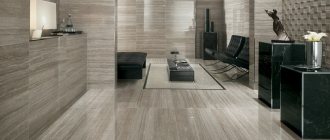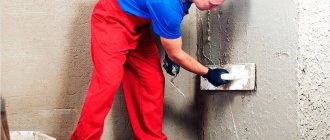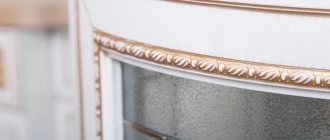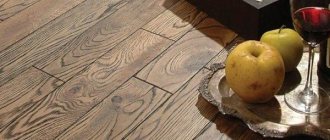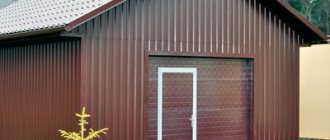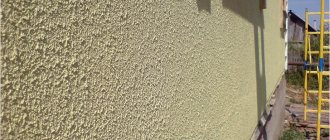Modern building and decorative material in the form of glass blocks provides ample opportunities for interior design. Using these glass “bricks”, you can implement the most unexpected solutions for decorating rooms. Such designs are very convenient to use - they transmit light perfectly and are characterized by high thermal and sound insulation. To mount a wall or partition from glass blocks, you will need to take into account some features of working with this material.
Properties of glass blocks
Many people remember fragments of walls and blind windows of industrial buildings and public premises made of glass blocks. Then this material was undeservedly forgotten for some time. Currently, glass blocks are experiencing a rebirth - using these products of a new format, it is possible to create unexpected and original solutions not only for the exterior decoration of private houses, but also for creating original and unique interiors of various premises.
Glass blocks are products made from two glass plates of thick glass (frosted, transparent, painted in the mass or with a pattern), connected to each other in a hermetically sealed structure. The air gap gives this building material excellent sound and heat insulation characteristics. Glass blocks are made with a smooth or corrugated surface. Depending on the relief, they can be transparent, scattering or directing light. On sale are glass blocks of rectangular and square shapes, as well as triangular, corner and even round products, with a thickness of 7.5 to 10 cm, weighing about 2.5-4.3 kg. Standard sizes of glass blocks are 19x19x8 or 24x24x12. There are samples of Euro glass blocks on sale, in which the ends are coated with paint - thanks to this, the mortar seams in the masonry do not show through.
This material has a number of advantages, including the following:
- natural composition;
- high wear resistance and durability - walls made of glass blocks are resistant to abrasion, mechanical damage, moisture, and temperature changes;
- due to the presence of an air gap, glass blocks retain heat well and provide excellent sound insulation, approaching in this indicator the characteristics of a brick wall or modern plastic double-glazed windows;
- a wall made of glass blocks can withstand even a mild earthquake. In addition, glass blocks are not flammable; in the event of a fire, they do not melt or crack for a long time;
- ease of assembly and ease of use - glass blocks are a unique building material that does not require subsequent finishing in the form of cladding or painting, since they themselves have pronounced decorative properties;
- moisture resistance, thanks to which glass blocks can be used for the construction of interior partitions and walls, as well as glazing windows in rooms with high humidity (in swimming pools, bathrooms, toilets).
Glass blocks effectively scatter the sun's rays without preventing their penetration into the room, giving the lighting softness and comfort. At the same time, transparent products provide the effect of a panoramic view, and corrugated ones close the room from prying eyes.
Glue method for laying glass blocks
- The block located at the edge is fixed on the guide horizontally.
- To connect vertical surfaces, special dividing strips are used.
- Before you start laying the second row, install the horizontal guide again and attach it to the wall.
- The glue can harden either quickly or over a long period, depending on its type.
- At the end, all joints are grouted with the required color, and then the blocks are washed from the solution that has fallen on them.
Application of glass blocks
Decorative glass blocks look very impressive in the interior of rooms of various styles. They are convenient to embed into various surfaces to decorate walls, windows, and partitions.
This material is used in construction for the following purposes:
- when remodeling housing for the construction of walls in a new, convenient option, since glass blocks allow you to build walls without weighing down the space. It should be noted that this material cannot be used for the construction of load-bearing walls, since such a load may be excessive for this building material. It is worth considering that a wall made of glass blocks, separating the room from the hall or corridor, lets in sunlight and will add illumination to the room, and embossed glass blocks will protect the room from prying eyes;
- A partition made of glass blocks with a flat or stepped top can be erected quickly and without much labor and time. This design is especially relevant in bathrooms and toilets. Since this material has water-repellent properties, it can be used to create bathing areas. Glass blocks in the bathroom allow you to zone different zones, protecting you from prying eyes when bathing and protecting the room from splashing water. Such glass block partitions look very harmonious in a room with high humidity. Showers made from glass blocks are safer to use than their glass counterparts.
Glass blocks in the interior of the apartment
The possibilities for using glass blocks for partitions in the interior are extensive. With their help, they decorate interior false walls of various shapes, enclose bathtubs and showers, create windows, columns and arches, and design flights of stairs.
Glass blocks will enliven and improve the interior design, decorated in a laconic style:
- minimalist;
- high tech;
- constructivist;
- pop Art;
- urban;
- eclectic;
- environmentally friendly;
- modern and postmodern;
- Art Deco.
But it is quite difficult to fit them into the classical, baroque or renaissance style, although it is possible as rare decorative elements.
Glass blocks successfully zone space: they can be used to separate the kitchen and recreation area in a studio apartment or to delimit the living room and hallway. Illuminated options look interesting, for example, a bar counter glowing from the inside or a decorative window made of colored glass blocks in the partition separating the sleeping area. And the most daring experimenters insert decorative elements into floor coverings.
How to install glass blocks with your own hands
To install glass blocks yourself, you will need to take into account a number of nuances of working with this building and decorative material. It is important to note that glass blocks can only form a built-in structure, which requires support in the form of a wall or an end post.
There are several methods for laying glass blocks:
- the classic method is using a wooden guide frame or a module made of a metal profile, which is attached to the floor, walls and ceiling. Cement mortar is used to secure the masonry; in addition, tile adhesive can be used as an adhesive for glass blocks. Tile adhesive is more viscous and elastic, while it dries quickly and fixes glass blocks efficiently;
- frame method - conveniently mount glass blocks on a base in the form of a special frame, and they must be fixed using a compact structure. To secure the masonry to the frame, you can use silicone sealant, liquid nails, etc.
The classic method of installing glass blocks
Before installation, the surface to be treated should be cleared of debris, dust and remnants of old finishing. Then you need to apply markings to the base base. To determine the size of the wooden module (frame) for fixing the masonry, you need to lay out a row of glass blocks and insert plastic dividers between them. After this, you should measure its length and height and calculate the required dimensions of the frame, which will be installed in place of the future laying of glass blocks. After drilling holes in the frame, it must be attached to the wall structure using 50 mm dowels and screws. To level the frame module, you can use wood chips placed between the wall and its supporting surface.
After preparing the base surface, you will need to prepare an adhesive mixture. To lay glass blocks, you can use tile adhesive or prepare a cement-sand mortar in a 1:3 ratio. In order to increase the plasticity of the mixture, it is recommended to add PVA glue to it (at the rate of 200 g of glue per five buckets of solution). When laying transparent glass blocks, it is preferable to use white adhesives - in this case, the seams of the structure will look more aesthetically pleasing. Please note that you should not prepare a large amount of adhesive solution at once, as it tends to harden quickly.
Before installation, it is necessary to check the integrity of the glass blocks, since manufacturers provide a guarantee for this material before installation work begins. The protective film should not be removed from the blocks until work is completed to prevent damage to the glass plates. If such a film is not available, you can use any polyethylene film, securing it to the surface of the blocks using paper tape.
When installing glass blocks, you should use reinforcement by laying rods made of galvanized or stainless steel wire vertically and horizontally in the masonry seams so that they form a metal mesh that secures the structure. To do this, reinforcing rods must be secured in the wall structure, fixing them in pre-prepared holes. Metal rods are laid on plastic mounting crosses, and contact with the glass should be avoided. At the end of the work, the crosses remain inside the masonry and are rubbed down.
To lay glass blocks, you can use the following step-by-step instructions:
- first you will need to install vertical reinforcing rods into the holes on the bottom of the frame;
- Next, apply an adhesive solution up to 1 cm thick to the horizontal surface of the frame at the bottom;
- Having laid the mortar on the side surface of the frame to fix the first glass block, you should install the first glass “brick” and fix it by pressing it into the layer of mortar;
- according to this principle, it is necessary to lay out the bottom row, leveling it with a mallet, and then install mounting crosses between the glass blocks, apply a layer of adhesive mixture on top and install a reinforcing horizontal rod, fixing it in a previously prepared hole;
- Next, you will need to sequentially lay glass blocks in rows according to the method described above, interspersing them with reinforcing rods.
To avoid subsidence and curvature of the constructed wall, it is recommended to carry out installation gradually - 3-5 rows at a time, leaving time for further drying of the seams for at least 12 hours. After fixing the glass blocks, remove excess adhesive mixture with a sponge.
After installation, you should wait until the structure dries completely - this will take several days. Next, you will need to carefully chop off the parts of the plastic crosses protruding from the masonry, if any. In addition, you should pay attention to the seams - in order for them to look quite aesthetically pleasing, it is necessary to apply a grouting composition of a suitable shade. To seal the seams you will need to use silicone sealant.
After completing the above work, you should thoroughly wipe the glass blocks with a clean cloth. If necessary, the remnants of the adhesive mixture can be removed from the surface of the glass using an anti-scale agent or hydrochloric acid solution - in this case, you will need to make sure that this liquid does not penetrate into the seams.
To install round-shaped structures made of glass blocks, the same classical installation method is used. The only difference is that with arched installation it is necessary to bend the horizontal reinforcement, giving it the desired shape in order to obtain a rounded wall. In this case, mounting crosses to adjust the thickness of laying seams must be used only on the inside of the structure. To lay the rounded part of the wall, it is recommended to use halves of glass blocks, since in this case a denser reinforcing mesh will be used, strengthening the structure. In addition, by using smaller bricks, it is easy to minimize the discrepancy between the external and internal seams, as a result of which the wall will look neater.
Frame method of installing glass blocks
To install glass blocks, you can use an easy-to-implement, but more expensive method of laying without cement mortar. This design is lighter and looks more aesthetically pleasing compared to the classic installation method.
To do this, you will need to use a specially made frame system in the form of a metal module or a wooden one (made from dry sanded boards) - with cells of a suitable size into which glass blocks are inserted. In this case, it is necessary that the cell size matches the size of the glass blocks with an accuracy of 2 mm. Such a structure will need to be painted in a suitable color and securely attached to the walls, floor and ceiling - for this you should use dowels or anchors. It is important to carefully align this module vertically and horizontally.
Next, you will need to place glass blocks into the cells of the prepared frame and fix them at the joints using silicone sealant, which resembles colorless rubber after hardening. It will take up to 10 hours for the joints to dry, after which the frame structure will be ready for use.
Basic rules for installing glass block partitions
Basic rules for all glass block structures:
- The surface under the lower tier must be perfectly flat.
- The use of glass block structures as load-bearing structures is excluded. Only fencing function, zoning and design. The point here is not the strength of the blocks themselves; it is enough with a reserve, because the thickness of the glass walls is about a centimeter (7-9mm). Significant weight and small thickness of the blocks require perfectly level and stable support, strong bracing, and strict verticality. Complex curved structures, including arched ones, are also made from glass blocks, but in these cases there is a supporting frame.
- The largest possible partition area is 15 m2. More is not possible for reasons of stability, since glass blocks are very heavy and collapse may occur.
- It is better to remove protective films from blocks as a last resort, after all finishing is completed.
Installation of glass blocks into a frame is simple and can be done even without experience. Installation on a mortar or adhesive mixture is labor-intensive and requires skills and constant alignment of the vertical and horizontal. Stability is the main condition for the safe operation of a glass block structure. Installation using the second method is usually trusted to specialists.
Materials and tools for laying glass blocks
The set of tools depends on the installation technology. If this is a wireframe diagram we will need:
- perforator;
- angle grinder (“grinder”), with a stone disc;
I recommend: Under the old linoleum there is old screed and dampness
If the frame is made of wood, a hacksaw with a fine tooth and a screwdriver will be added to the above.
For masonry with an adhesive mixture, you need a regular set of tools for masonry: trowel - trowel, string. The only thing we need is a mason's hammer - we'll replace the pick with a rubber mallet. It can be used to tap and upset the glass block without fear of breaking the fragile glass.
And of course, in both cases, for marking you will need a building level, tape measure, marker, and square.
The masonry mixture is sold ready-made. But if you want, it’s easy to prepare it yourself. Ordinary cement mortar based on grade 400 cement with a ratio of 1:3 is quite suitable. But there are a couple of nuances:
- Be sure to add PVA emulsion to the cement mixture, about a glass, per bucket of mortar.
PVA will add plasticity, as well as some “stickiness”, without which it will be inconvenient to work.
- To get a good quality partition, it is usually better to use white cement. A regular grayish seam will be visible through the transparent body of the glass block, which is not always desirable.
If the masonry is made from blocks whose glass is colored in a certain tone, the masonry mixture can be given the required color by adding a coloring pigment to the mixture.
The blocks are pressed down with a soft rubber mallet so as not to break the fragile glass.
